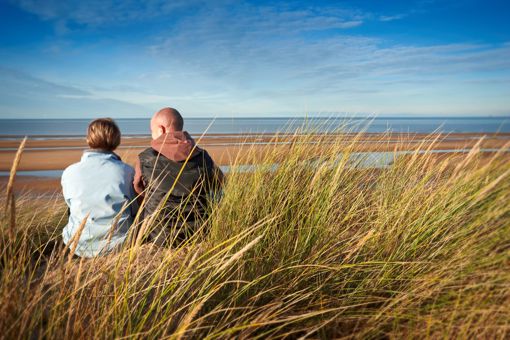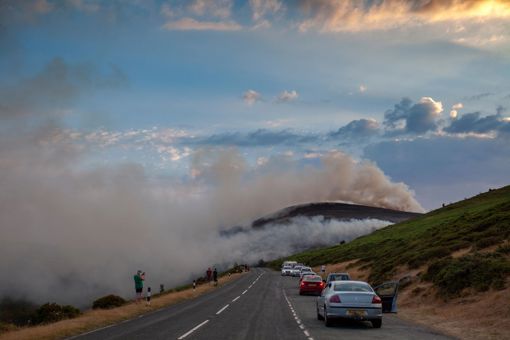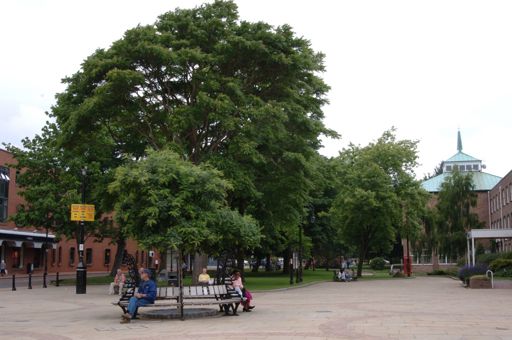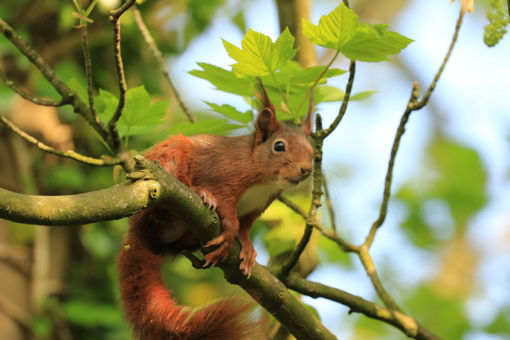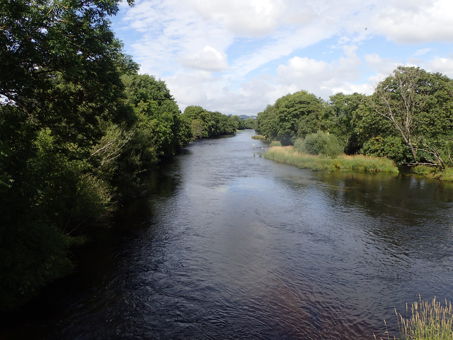Increasing woodland cover for social, environmental and economic benefits
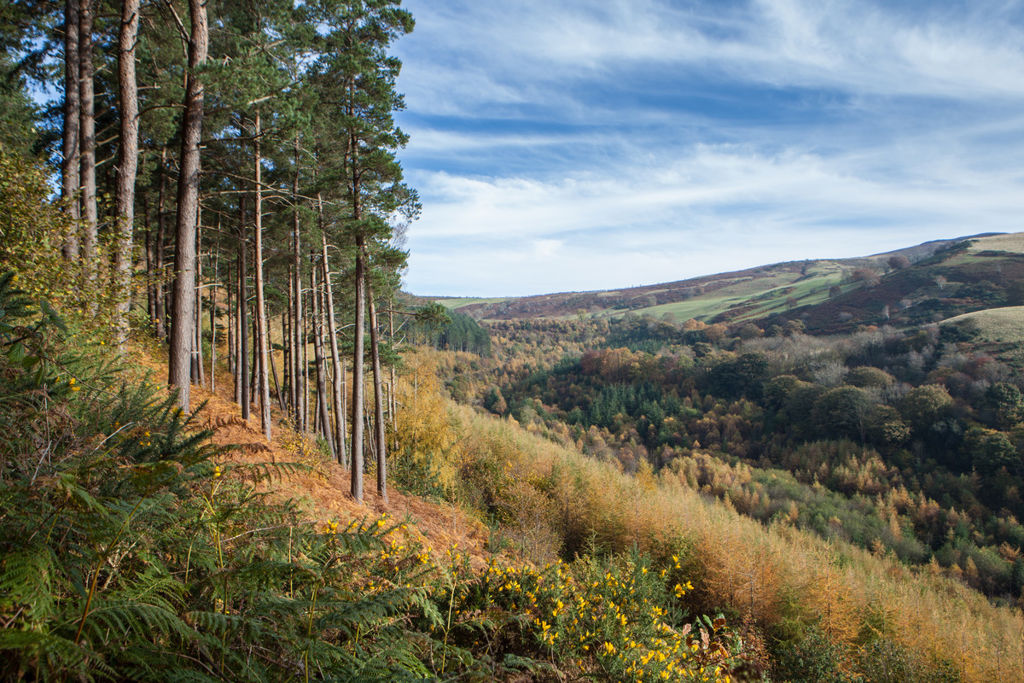
Why this theme?
With the Welsh Government having declared a climate emergency, there is currently a sense of urgency in Wales (supported by strong policy and strategic frameworks) surrounding opportunities to create new woodlands. Trees help regulate our climate, reduce noise, store carbon, safeguard soils, improve air quality and reduce flood risk. They create jobs and income from timber and other activities. They play a major role in pollination, soil formation, nutrient cycling, water cycling and oxygen production. In fact planting trees and woodland creation spans all five of the themes that make up the North East Wales Area Statement (featuring strongly in the ‘Develop and improve urban/rural green infrastructure’ theme).
The Welsh Government Woodland Estate (WGWE), which is managed by Natural Resources Wales (NRW), makes a valuable contribution to the environmental, economic, social, health and well-being of our communities, alongside other privately owned forests and woodlands in North East Wales.
The county of Wrexham is characterised by small blocks of farm woodland together with larger rural estates. Woodlands cover 9.4% of the county, well below the Welsh national average of 14% (none of which, it should be noted, is freehold WGWE with public access). Flintshire’s woodland cover is slightly higher at 9.8%. Of that, 0.4% is WGWE predominantly made up of Coed Moel Famau, a large forest situated in the Clwydian Range and Dee Valley Area of Outstanding Natural Beauty straddling the border with Denbighshire, along with Coed Nercwys (also in the AONB) near Mold. Farm woodland and rural estates make up Flintshire’s private woodland.
Denbighshire’s woodland cover is dominated by the extensive Clwydian Range upland plateau areas along with, again, small blocks of farm woodland and rural estates. Clocaenog Forest, covering 4,166 hectares and generating annual timber income of between £1.5 – 2 million, is also managed in a way that conserves and enhances wildlife, generates electricity and provides recreation for walkers, cyclists and horse riders. Conversely, tree cover in deprived areas tends to be lower and less rich in terms of amenity trees. Take, for example, parts of Rhyl where as little as 1% of the surface area is made up of trees.
Clocaenog also employs a trial forest management technique known as continuous cover silviculture that requires wider consideration. This process involves creating more diverse forests, both structurally and in terms of species composition, by avoiding large scale clear-felling. The development of more diverse forests is a sensible way of reducing the risks posed by future changes to the climate.
It is estimated that the forestry industry in North East Wales employs 3,000 people directly and indirectly including three sawmills, the country’s largest forestry nursery and many contractor businesses. It is vitally important that our woodlands continue to sustain local communities and the businesses within them.
Located in private woodland, the Llandegla Mountain Bike Centre is now one of Denbighshire’s largest tourist attractions drawing nearly 200,000 visitors each year. It offers mountain biking and trail walking based around a visitor centre run by the Oneplanet Adventure company.
Elsewhere, there are widespread examples of wet woodland (Coed Talon Marsh, Sontley Marsh, Llay Bog, Llyn Bedydd and Big Pool Wood, all Sites of Special Scientific Interest) together with rare floodplain woodlands (Llwyn Special Area of Conservation) and upland mixed ash woodlands (Alyn Valley Woods SAC and Elwy Valley Woods SAC).
Ancient woodlands in North East Wales are fragmented and, because of this, require protection. In fact all woodland habitats need to be managed carefully to make the most of the many benefits they provide, ensuring they are resilient, resistant and adaptable for future generations to appreciate. We also need to seek opportunities to increase broadleaved, mixed and conifer woodland on private and public land reflecting local character, culture and providing opportunities for communities (including reducing the impact of deprivation).

It is vital that communities feel connected to the decision-making process surrounding woodland creation, enabling people to fully benefit from what’s on offer. That could mean collaboration across localities or planting in spaces that traditionally might not have been considered, for instance areas in or close to urban communities. Trees in built-up environments help mitigate some of the negative consequences of urbanisation, making communities more resilient to change.
That said, it is important a balance is struck, and that we find space for trees in ways that aren’t detrimental to other important land uses (such as sustainable agricultural food or land management systems). In addition, following the principle of ‘the right tree in the right place’ will ensure that important areas that are already storing significant carbon, or hold value for habitats or species of local, national or international importance, are not planted with trees where there are negative effects.
Improving the management of existing woodlands, along with the more widespread use of trees, is a Natural Resources Policy (NRP) priority. In addition, increasing woodland cover for social, environmental and economic purposes in North East Wales would also help deliver the following NRP priorities:
Reverse the decline in biodiversity
Woodlands and forests are good for wildlife and can join areas of valuable habitat together. A landscape connecting new and existing woodlands will, therefore, help maintain and enhance biodiversity, with care being taken to (a) plant trees in the right places, and (b) make sure the right species of trees are being planted.
Reduce pollution levels in our air and enhance air quality
Research in recent years by the Woodland Trust has identified how urban greening and tree planting can be tailored to achieving air quality goals, whilst still fulfilling many of the other beneficial functions of urban green space. Trees are essentially a cost-effective solution addressing deteriorating air quality as well as rising urban temperatures.
Reduce noise pollution
There is a growing body of evidence which suggests that noise pollution (road, rail and air traffic, industry, construction, public works, etc) has an impact on our health. Green spaces can mitigate noise levels in urban areas. Planting ‘noise buffers’ made up of trees and shrubs cuts sound by five to 10 decibels for every 30 metres width of woodland, reducing noise by approximately 50%. However, to achieve this, the species and planting design must be chosen carefully.
Improve the quality, and ensure the quantity, of our water
Trees and woodland can help reduce flooding and improve water quality in various ways such as intercepting rain, allowing infiltration to the ground, reducing the volume and speed of run-off into drains and watercourses, drawing water up from the ground for transpiration, removing pollutants and decreasing sedimentation.
In North East Wales, two main catchments dominate – the River Clwyd and the River Dee. Most of the River Clwyd catchment is within North East Wales with one major tributary, the River Elwy, lying mainly in NRW’s North West area. The upper Dee also stretches into the North West area, with the lower catchment flowing over the English border into the Cheshire Plain and the Dee estuary.
Nearly three million people get their drinking water from the Dee, many of them living in North West England. The strategic importance of the Dee as a potable water source, and the risk posed to it from pollution, has led to the river becoming one of the most protected in Europe and, as of 1999, a designated Water Protection Zone.
The Clwyd has its headwaters in Clocaenog Forest, while the Elwy rises to the west on the Denbigh Moors. Agriculture dominates the largely rural Clwyd catchment. Part of the lower catchment is a nitrate vulnerable zone for both surface and groundwater. In 2015, 68% of all freshwater water bodies (as defined by the Water Framework Directive) were not achieving good or better overall status in North East Wales. Contributory factors included:
- Physical modification, responsible for 22% of failures due to pressures such as barriers to fish migration (e.g. weirs)
- Pollution from sewage and wastewater, responsible for 22% of failures
- Pollution from rural areas (including land management practices as well as impacts from other uses, for instance horses/stables, golf courses), responsible for 24% of failures
- Pollution from towns, cities and transport, responsible for 8% of failures
- Pollution from mines, responsible for 6% of failures
NRW has been working closely (and will continue to do so) with our stakeholders including Dwr Cymru/Welsh Water and farmers in the Clwyd catchment to ensure that our bathing waters at Rhyl and Prestatyn achieve sufficient, good or excellent status. We will continue to seek funding and liaise with partners to deliver schemes that reduce bacteriological inputs in the catchment. Dwr Cymru has designated the Clwyd catchment as a Sustainable Management of Natural Resources (SMNR) pilot and wants to work collaboratively to deliver environmental improvements along with health and well-being benefits.
Reduce the risk of flooding to land and coast
Trees can prevent flooding by slowing the flow of water along with intercepting and evaporating rain, increasing water absorption through soil, roughening up land surfaces and decreasing soil erosion.
Climate change adaptation
Maintaining our existing trees and woodlands, along with sympathetic new planting schemes, can play a crucial role in helping North East Wales adapt to climate change by offsetting and storing carbon.

What would success look like?
The woodlands that make up the Welsh Government Woodland Estate are managed by NRW on behalf of the people of Wales. These are some of our greatest natural assets and, because they are in public ownership, have a unique contribution to make. In essence, the WGWE is a woodland resource that generates environmental, economic, social and cultural benefits for the people of Wales and beyond, now and for future generations.
In managing the WGWE in North East Wales, NRW will ensure that the following principles from The Purpose and Role of the Welsh Government Woodland Estate are met:
- North East Wales’ area of woodland resource will be bigger in 25 years than it was in 2018
- Management of the WGWE will comply with the United Kingdom Forestry Standard (UKFS) and forest certification will be maintained
- The WGWE will support the well-being of Wales, including through collaboration with others
- The WGWE should contribute to the prosperity of the people of Wales, with income from the woodland estate being reinvested into ongoing sustainable forest management
The following opportunities for private and public owned woodland were identified through the Area Statement engagement process:
Developing a North East Wales woodland creation hub
A North East Wales woodland creation hub, providing a single point of contact for enquiries on all tree planting and woodland creation in the area, should be established and supported by a network of partners and organisations. Advice is an essential part of tree planting and needs to be integral to the process (regardless of the scale of tree planting). This might include where to plant trees, what species to plant, how to manage trees and where to source UK grown trees and shrubs, minimising the risk of importing pests and diseases.
Tree planting is often seen as the end point of the project but, in reality, it is far more important than that, laying the foundations whereby the trees survive and deliver benefits such as carbon storage, along with habitats for flora and fauna. As well as providing advice and guidance, the hub would also signpost opportunities for funding, whether for small community tree planting projects or commercial forestry.
Using existing evidence
By using existing evidence (for example, i-tree), areas can be identified where NRW and our partners might work together to increase the urban tree canopy for the benefit of the environment and communities. At a workshop in December 2019, Wrexham County Council talked briefly about potentially managing council farms differently, as and when opportunities arise, in order to plant woodlands. It’s worth noting that Wrexham, as a county, has no freehold Welsh Government woodland estate.
Area Statements should create opportunities for new woodland, seeking better incentives for all land managers
There needs to be a strategic, simple funding approach to all woodland-related schemes. Many stakeholders are confused by the complexity of the current woodland creation process, including how best to seek advice and potential funding options. The need for an adaptable grant scheme at place level has been raised through our engagement process. Schemes like Glastir should be fit for purpose and offer support beyond the establishment phase. The payments system needs to promote various levels of woodland creation, not just large scale, focusing on wider ecosystem services. Communities should be able to benefit from carbon sequestration funding.
In addition, the Area Statement should consider and promote trees and woodland in the context of land management, ensuring that new planting compliments rather than competes against agricultural interests and sustainable food production. Hedgerows could also be maintained and enhanced, along with incentives being made available to landowners to plant trees on their least productive areas of land (hedgerow loss was a particular concern among those attending the Ruthin engagement event in November 2019). In some instances, support should be given to allow the natural regeneration of woodland, which can be much more cost effective than planting trees.
Welsh National Forest and links with The Mersey Forest
As a principal advisor to the government, NRW will inform on Area Statement discussions surrounding the Welsh National Forest. In North East Wales, it is hoped a National Forest would help create a mosaic of woodlands, opening up green spaces linking existing woodlands and connecting rural and urban areas, delivering numerous environmental, social and economic benefits in the process (similar to The Mersey Forest initiative which seeks to create woodland and green space across the Wales/England border in North Cheshire and Merseyside).
Natural flood risk management using nature-based solutions
Trees have long been known to reduce flood flows by evaporating water, increasing water absorption through soil, roughening land surfaces and decreasing soil erosion. We need to work with nature to explore new approaches to flood management, considering measures at the catchment level that mitigate the risk of flooding downstream, as well as providing multiple benefits to local communities. One local authority, keen to reduce the impact of flooding in their area, demonstrated ‘upstream thinking’ by wanting to plant trees in a neighbouring authority.
Increase the urban tree canopy
Trees can provide protection from pollution, capture carbon, create space for wildlife and enrich the environment, at the same time boosting the image and prosperity of a locality by enriching the environment. The Area Statement will support communities in providing effective protection from polluted air, creating a clean ‘green corridor’ for active travel and making space for wildlife. This can be done by increasing the urban tree canopy in deprived communities, encouraging communities to aim for the UK Forestry Standard (thereby creating ‘woodland’ towns) and responding to the ash dieback emergency by replacing lost amenity trees.
Influencing Local Development Plans
Local Development Plans should contain positive policies surrounding trees and woodland. Planning systems need to allow for, and incorporate, tree planting and woodland creation into developments.
Creating a ‘Story Map’ engagement tool
The creation of a ‘Story Map’ public engagement tool would enable people to follow progress, showing evidence and success against the theme. This, in turn, could enable further change, influence opinion and raise awareness. The maps would be designed for any audience with access to the internet.
Developing case studies
Stories matter. They engage us, therefore we learn from them. We need to develop and share case studies about planting trees and woodland creation that showcase the successes. These case studies should also tackle the common misconception that environmental benefits are delivered at a cost to economic development.
Who have we worked with to date?
In total, 148 people representing 68 organisations across 28 different sectors (with wide-ranging remits) attended five engagement events staged by NRW over the course of 2019. All but one took place at local community venues, the exception being the larger, civic setting of Denbigh Town Hall in July. We also engaged with senior management and portfolio leads of all three local authorities in North East Wales.
Dafydd Thomas, an external well-being consultant, was present at each event which featured an innovative procedure called ‘meeting sphere’ designed to encourage participants to share their true feelings, prioritise what really mattered to them, and work together to get results.
The discussions surrounding tree planting and woodland creation were informative and constructive at all the engagement events. There was representation from a wide range of sectors directly associated with woodland creation and commercial forestry together with conservation, recreation and access, local authorities and Public Health Wales. Many of the organisations had significant experience in woodland creation and were able to make valuable suggestions about how the ‘vision’ could be delivered. Others were able to champion the health and well-being benefits of trees.
Despite many sectors being well represented, NRW is aware that we need to broaden the appeal of Area Statements beyond those who we routinely engage with. We would like communities and the non-environmental sector to be involved (up until now, non-environmental sector participants accounted for only 15% of those engaged). Working together with Flintshire County Council, invites were sent to approximately 2,500 small and medium-sized businesses, yet the response to date has been disappointing. We have, however, worked with the Young Wales organisation which ran a series of workshops across North East Wales that will contribute to the Area Statement and, in the process, engage and empower young people.
We have always recognised how important engaging with communities is, and we are in the process of considering how best to do that in order to make the most of the opportunities that have been discussed to date. Rest assured, NRW will be encouraging and supporting communities to come together to form groups that share common goals or purposes, helping them shape and deliver the Area Statement so that it benefits their localities.

What are the next steps?
Throughout 2020 we will continue to work with stakeholders as we start to deliver the opportunities identified through the Area Statement. We expect further opportunities to arise as the engagement process continues.
Actions for NRW and stakeholders include:
- Looking to broaden the appeal of the Area Statement process, encouraging organisations to understand that this is something they can shape, influence and engage with
- Keeping the Area Statement constantly under review, reflecting new ideas and evidence that comes to light, along with discussions which take place
- Continuing to map our stakeholder engagement carefully, reaching out to sectors and organisations we have not yet talked to
- Supporting communities to come together and form groups that contribute to the Area Statement, getting more of a sense in the process about whether the opportunities being identified are in fact the right ones
- Encouraging a diverse range of stakeholders to come together and form a ‘theme’ focus group to further develop the opportunities identified
- Encouraging new ways of working, new relationships to be formed, and continuing to build trust with our existing partners
- Incorporating feedback from the Youth Wales engagement sessions into the Area Statement
- Signposting partners and communities towards funding opportunities that support the delivery of the Area Statement, including NRW’s own grant funding programme
- Raising specific points and discussions around policy relating to Area Statements, in our role as principal adviser to the Welsh Government
- Improving our use of social media, while considering other innovative ways to involve people in the Area Statements process
How does what we’ve proposed deliver Sustainable Management of Natural Resources (SMNR)?
The principles underpinning the Sustainable Management of Natural Resources (SMNR) are pivotal to the Area Statements process. At the heart of its development has been our collaborative engagement with a broad range of partners and stakeholders, both existing and new. We have tried to start conversations that matter, asking people to talk to people they don’t know, or would never normally speak to. By doing so, it became clear that many shared a similar vision of the future, one that ultimately laid the foundations for our five themes. While some of those conversations were challenging, they always proved worthwhile and productive.
This process has helped us collaboratively define the problem and gain an understanding of the opportunities and potential actions, prior to deciding what needs to be done to achieve our shared ‘vision’. This represents a significant change in how NRW works. In the past we may, on occasion, have gone ahead with our preferred options without engaging or seeking any kind of consensus. The challenge now is to work together with our partners, stakeholders and communities in moulding, and ultimately delivering, these opportunities.
The Area Statement will allow us all to make clear, evidence-based decisions, drawing not only on information that we hold but also evidence our partners provide. Much of the data will be made available to all through NRW’s new data portal. NRW has developed a spatial mapping model (SCCAN Opportunity maps) to support development planning, in particular surrounding urban green infrastructure, woodland creation and biodiversity. This, alongside some of the evidence that our stakeholders have gathered, should ensure that Area Statements will be a vital cog in the development of local development plans. We do, however, appreciate that there are still gaps in our evidence, but we’re working to plug them.
Furthermore, we know that we need to protect our ecosystems and the services they provide by building resilience. There is a strong relationship between increasing woodland cover, our other four Area Statement themes, and the opportunity to deliver multiple benefits that interlink. All these themes are designed to make our ecosystem services more resilient, to mitigate against climate change, and to help our communities adapt to a changing climate. Again, some of the detail surrounding how best to take these opportunities forward have yet to be addressed. However, we know that many are scalable either by following the North East Wales path defined here, or by taking more of a regional approach.
How can people get involved?
In North East Wales, we envisage that people will be able to get involved in the discussion surrounding woodland creation by way of further engagement. Details will be announced as the Area Statements process evolves. Watch this space, in other words. Should you wish to find out more, please don’t hesitate to complete the following form or email us at northeast.as@naturalresourceswales.gov.uk

